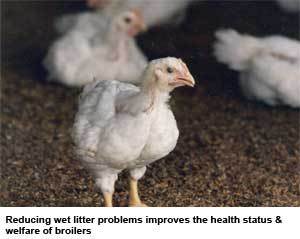Target release Na-butyrate to fight major health and litter problems

A damaged intestinal wall provides opportunities for bacteria to cause health and litter problems. Recent studies have shown that butyrate plays an important role in the protection of the intestinal wall. Through target release coating, butyrate arrives at the right place in the intestines to reduce necrotic infections.
By Pim Langhout, Annelies Diericx and Stephan Bauwens, Nutriad International NV, Kasterlee, Belgium (p.langhout@nutriad.net)
The impressive genetic improvement of broiler growth rate has been a major factor that enabled the poultry industry to meet with increased demand for poultry meat. The improving growth figures and the corresponding feed conversions in meat production are linked with wet litter problems, resulting in many cases to health problems. Most of these problems are related to suboptimal functioning of the digestive system. These digestive problems are often associated with a lower integrity of the intestinal wall and a disruption of the ecosystem in the gastrointestinal tract resulting in so-called dysbacteriosis or even clostridium infections.
Regulations enforcing action
Together with the rise in global poultry production is an increase in public and political concern with regards to food safety and animal welfare. In the EU this already resulted, since 2006, in banning antibiotic growth promoters. Today, the poultry industry is facing more stringent regulations regarding animal welfare. An important element here is that litter quality has to remain high during the growing period to avoid food pad dermatitis and hock burns. This implies that producers need to prevent digestion problems, because they increase the risk for food pad dermatitis and health problems. Feeding strategies have to be developed by using nutritional factors that can improve gut integrity of the modern broiler.
Influencing the digestive tract
Research has demonstrated the impact of several nutritional factors on the functioning of the digestive system. Most of these nutritional factors are based on the principles to optimise the passage rate of the feed through the intestinal tract, as well as to balance the nutrient supply, particularly in the lower part of the digestive tract. These principles were thought to optimise gut function and balance the micro flora in the intestinal tract.
An example of a nutritional factor that affects the passage rate of feed is the presence of coarse particles in the diet. Coarse particles increase the time that the feed stays in the gizzard for grinding, which improves the flow of the feed from the gizzard into the small intestine. Other factors that affect the passage rate of feed through the intestinal tract are the type of grain in the diet and/or the fat source and the fat level. Here, balancing dietary protein levels (read balanced amino acid profile) play an important role in controlling the intestinal micro flora. A number of feed additives have shown to also play a role in the development of a healthy digestive system. Butyrate, for example, is one of the molecules of which the mode of action is best described in literature.
Butyrate improves gut integrity
Numerous trials have shown that butyrate plays an important role in the development of the intestinal wall, resulting in reduced litter problems and fewer health problems. It was thought that this effect of butyrate on the intestinal wall was due to the fact that butyrate was the main energy source for cell proliferation. Recent studies, however, have shown that the effects of butyrate in the intestinal lumen are induced via the activation of specific receptors in the epithelial cells. When present in the lower part of the intestinal tract, butyrate can also eliminate colonisation of detrimental bacteria such as E. Coli and Salmonella by inhibiting the expression of the gene that is responsible for the invasion of the epithelial cells.
The above findings make it clear that butyrate can only be effective in improving gut integrity when it arrives in the lower part of the intestinal tract. Consequently, a proper coating of the butyrate is necessary. Encapsulation of the molecules in a fat matrix allows butyrate to be slowly released when moving further down the digestive tract. This process is called ‘target release’.
Target release Na-butyrate reduces Clostridium impact
The efficacy of a butyrate source that was coated according to the target release principles has been tested in Clostridium challenged birds during 1-40 days of age. The birds (Ross 308) were challenged by contaminating all pens with litter from a commercial farm with acute Necrotic Enteritis problems before the day-old chicks arrived. The contaminated litter was checked for the presence of Clostridium spores. The trial consisted of three treatment groups: a negative control (no additives), a positive control (BMD at 55 ppm until 35 d) and a group supplemented with coated butyrate (Adimix 30 Coated). The Adimix 30 Coated was tested at a dose level of 1,000 ppm, 750 ppm and 500 ppm in starter 1, starter 2 and the grower/finisher, respectively.
Results showed that the inclusion of Adimix 30 Coated in the diet, as compared to the negative control, increased body weight (Table). Growth rate was comparable to the positive control. Mortality rate was significantly reduced when Adimix 30 Coated was added to the diet as compared to the control diets. The latter may indicate that the animals were suffering less from the Clostridium challenge as a result of the improved gut integrity.
Besides the performance data, the incidence of birds with liquid excreta was also measured. At 25 days of age, two birds per pen were examined for wet excreta. In the Figure the percentage of birds with wet excreta is given. The birds fed on the diet with Adimix 30 Coated showed a clear decrease.
The described trial clearly indicates that butyrate, when protected with a target release coating, can play an important role in feeding broilers. It reduces wet litter problems and consequently improves the health status and animal welfare. Results show that coated butyrate can replace antibiotic growth promoters, which enables the poultry industry to meet regulations and consumer demands.













